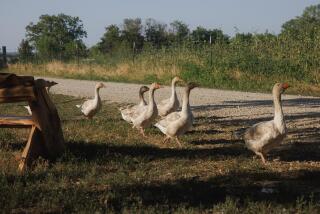Review: ‘The Biggest Little Farm’ is a winning doc about a couple’s agricultural dream
- Share via
Few things have sent up our food-conscious era quite so accurately (or affectionately) as that first-season “Portlandia” sketch in which a restaurant waiter is given the third degree by concerned patrons over the bona fides of the menu’s locally raised chicken. (“It’s not some guy on a yacht in Miami saying he’s organic?”) But the truth is, once you absorb back-to-the-earth porn as lovingly crafted as “The Biggest Little Farm,” you might just turn into one of those market gadflies who wants nothing but the most authentic story behind that dewy stone fruit or mocha brown egg. The doc, about the Chester family’s biodynamic Eden, Apricot Lane Farms, up in Moorpark, was eight years in the making for John Chester.
As commercially tinged as the Chesters’ gorgeously shot, widescreen advertisement for their progressive project ultimately is, we’ve needed an inspiring slice of farm-fabulous nonfiction, if only to act as motivational counterprogramming to the gloomy nature of most food docs. There’s been no shortage of activist screeds leading us through the evils, usually corporate in nature, that contaminate our food supply, be it animal treatment, use of chemicals, government policy that cripples small farmers, or the ravages caused by man-made climate change. (Every environmental doc, after all, is inherently a food doc.)
That’s why “Biggest Little Farm,” with its lush tour of transformed land and photogenic fauna, is so appealing as a chronicle of dedicated do-gooders who actually did good (and shot every frame of it). After a prologue in which California wildfires portend disaster for the farm, John narrates us back to the couple’s origins, when he and Molly were Santa Monica apartment dwellers making do as, respectively, a reality-TV/nature-doc cameraman and a private chef. The introduction of a rescue dog into their lives — its barks turning them into unpopular neighbors — triggers an urge to forgo urban living completely and kickstart their longstanding dream of owning a farm.
Life on the ‘Biggest Little Farm’: behind the scenes of a biodynamic blockbuster »
Spurred by the notion of reviving a long-neglected form of agriculture, they purchased 200 acres of soil-dead land north of Los Angeles. With the help of eccentric biodynamic expert Alan York, cultivated investors, young hirees drawn to the Chesters’ mission, and old hands from the area, they embarked on turning it into a diverse, nutrient-rich farm capable of growing anything and everything. They thought big, reviving an irrigation pond, building a worm compost facility, setting up a multi-fruit orchard, and bringing in a pregnant sow named Emma — the movie’s marquee animal star — whose litter they expected to be six but that turned out to be 17.
Early optimism quickly gave way to the vicissitudes of depending on Mother Nature, and it’s at this point that “Biggest Little Farm” reaps its real rewards. Watching the Chesters fight past disillusionment to learn the real lessons of harvesting in communion with nature is what gives the movie its rousing, illuminating power. Returning wildlife are beautiful (ducks! snails!) until some prove to be pests (thousands of snails eating the crops!), at which point patient human observation (ducks eat snails!) suggests a natural fix (ducks, meet our orchard!) and returns the farm to fertile glory. Even John’s engagement with the farm’s most persistent, scariest threat — coyotes — takes a surprisingly complex, respectful turn in keeping with the understanding that wildlife is an issue of integration, not eradication.
With cameras seemingly everywhere to capture the Chesters’ education, and the close-up majesty of their ecosystem’s cycle of give and take, life and death, separation and connection — including an oddball barnyard marriage between Emma and an outsider rooster named Greasy, and incredible night footage of owls whose appearance solves their gopher problem — the movie almost veers into seeming overproduced.
But the combination of technique and message is ultimately winning. It’s tempting to think of “Biggest Little Farm” as the real-life equivalent of an epic pastoral storybook tale, but with the kind of happy ending that suggests a blueprint for saving the earth. You can imagine Farmer Hoggett from “Babe” looking kindly on this movie’s hardworking couple and muttering, “That’ll do, Chesters. That’ll do.”
------------
‘The Biggest Little Farm’
Rated: PG, for mild thematic elements
Running time: 1 hour, 31 minutes
Playing: Starts May 10, Arclight Hollywood; the Landmark, West L.A.
More to Read
Only good movies
Get the Indie Focus newsletter, Mark Olsen's weekly guide to the world of cinema.
You may occasionally receive promotional content from the Los Angeles Times.










